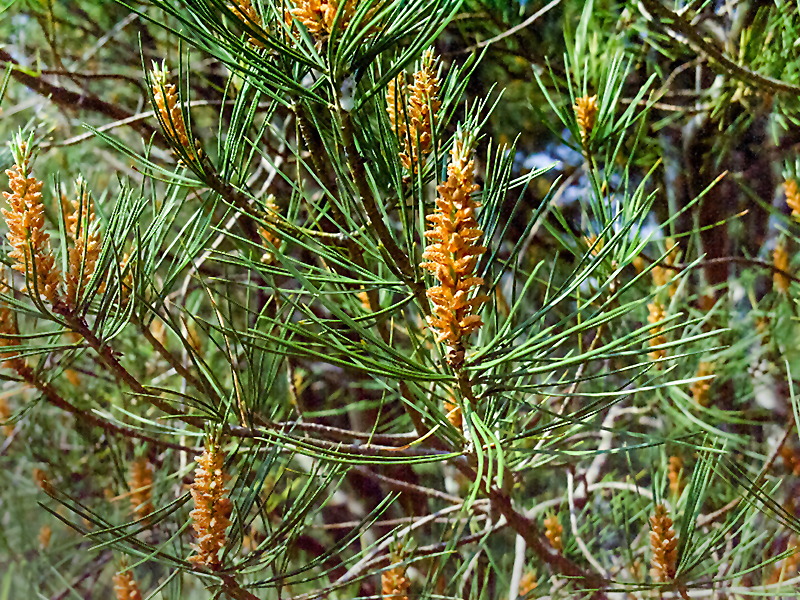
Woody > Pinus > Pinus banksiana > Pinus banksiana
Pinus banksiana
Jack Pine
Origin: Originally found on the East Coast of Canada by Sir Joseph Banks.
Mike's
Opinion


"
This tree is extremely hardy and cold tolerant. It is a plant of no ornamental value that I can see, however it is picturesque it its native environment; the accompanying photographs taken in the French River District, Ontario.
Michael Pascoe, NDP., ODH., CLT., MSc. (Plant Conservation)
"
| Family |
| Pinaceae |
| Genus |
| Pinus |
| Species |
| banksiana |
| Category |
| Woody |
| Type |
| Tree (evergreen) |
| Pronunciation |
| USDA Hardiness Zone |
| 2 - 6 |
| Canadian Hardiness Zone |
| 0a – 5b |
| RHS Hardiness Zone |
| H7 |
| Temperature (°C) |
| -46 - (-21) |
| Temperature (°F) |
| -50 - (-5) |
| Height |
| 12 - 25 m |
| Spread |
| 6 - 9 m |
Photographs
Description and Growing Information
Flowering Period
| General Description |
| Medium to large-sized, 17–21 m high, evergreen conifer. Crown, small and irregular. Trunk, dark and scaly at first, developing scaly ridges later. Branchlets yellow to greenish-brown when young, turning grey-brown with age. Very resinous buds. |
| Landscape |
| Windbreaks, shelterbelts; deer resistant and salt tolerant. |
| Cultivation |
| Easily transplanted if root pruned. |
| Shape |
| Pyramidal, open and spreading in youth, conical crown, shrubby and flat-topped at maturity. |
| Growth |
| Slow |
| ID Characteristic |
| One of the least shade-tolerant trees in its native range. Important commercial timber species. Wood is used for pulpwood, lumber, telephone poles, fence posts, and railroad ties. Only known nesting site for Kirtland’s Warbler, an endangered species. |
| Pests |
| Root borers, root feeders, shoot and stem borers, leaf feeders, needle miners, and sucking insects affect the survival of seedlings. Many other insects feed on the cones. Susceptible to many diseases including rust fungi. |
| Habitat |
| Poor or disturbed areas after fire or clear-cut logging. Grows on sandy soils, loamy soils, on thin soils over granites and metamorphosed rocks of the Canadian Shield, over limestone, on peats, and on soil over permafrost. |
| Bark/Stem Description |
| Thin, reddish brown to grey on young stems, becoming dark brown and flaky. Furrowed into irregular thick plates on old trunks. |
| Flower/Leaf Bud Description |
| Dark brown, 0.3–0.5 cm long, cylindrical, very resinous with closely pressed scales. |
| Leaf Description |
| Light green, 2 - 5 cm long, bundled in pairs, with a persistent sheath at the base. They are finely toothed, spread widely apart, slightly twisted, short, stiff, yellowish-green and sharply pointed. |
| Flower Description |
| Monoecious, staminate, cylindrical, yellowish, clustered at twig tips; pistillate, oval, reddish, appearing in May. |
| Fruit Description |
| Cones are 3.75–5 cm long, curved pointing towards the end of the the branches, light brown, turning greyish with age. Cones are persistent for several years and are resinous and closed. Cones require heat from the sun or a fire to release the seeds. The cones may persist on the trees fro several years. |
| Colour Description |
| Light green to dark green when young, olive green at maturity. Sickly yellow-green in winter. |
| Texture Description |
| Medium to coarse, scrubby looking with age due to the cones being retained for several years. |
| Notable Specimens |
| The University of Western Ontario, London, Ontario, Canada. |
| Propagation |
| Seeds have no dormancy and will germinate immediately. A light stratification of 6 weeks at 4°C can improve the germination of stored seed. Plant seedlings in their permanent sites as soon as possible and protect them for the first winter or two. |
| Ethnobotanical Uses (Disclaimer) |
| Mainly used for pulp as the wood is quite knotty. The wood is also used in the construction of boxes, crates and rough construction. |
-1.jpg)

-1.jpg)
-1.jpg)
-1.jpg)